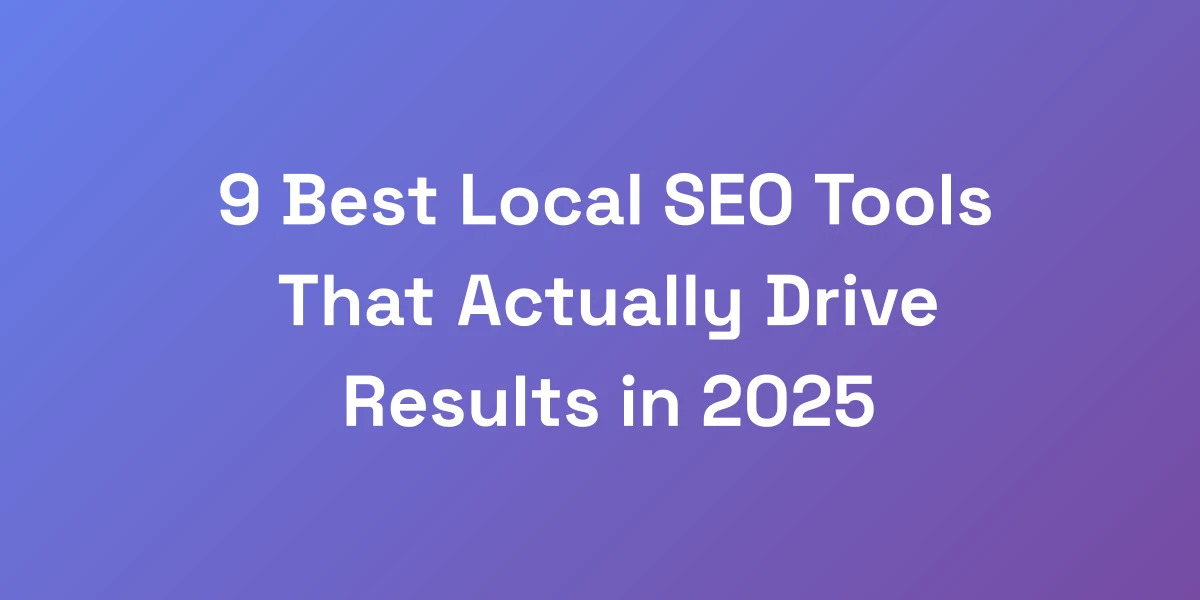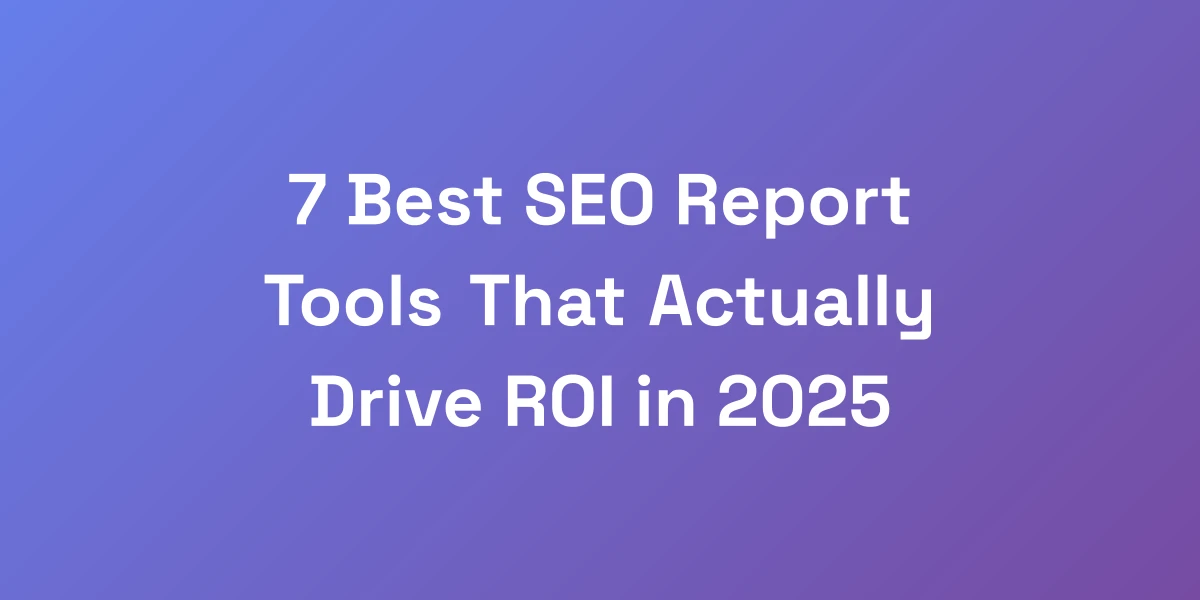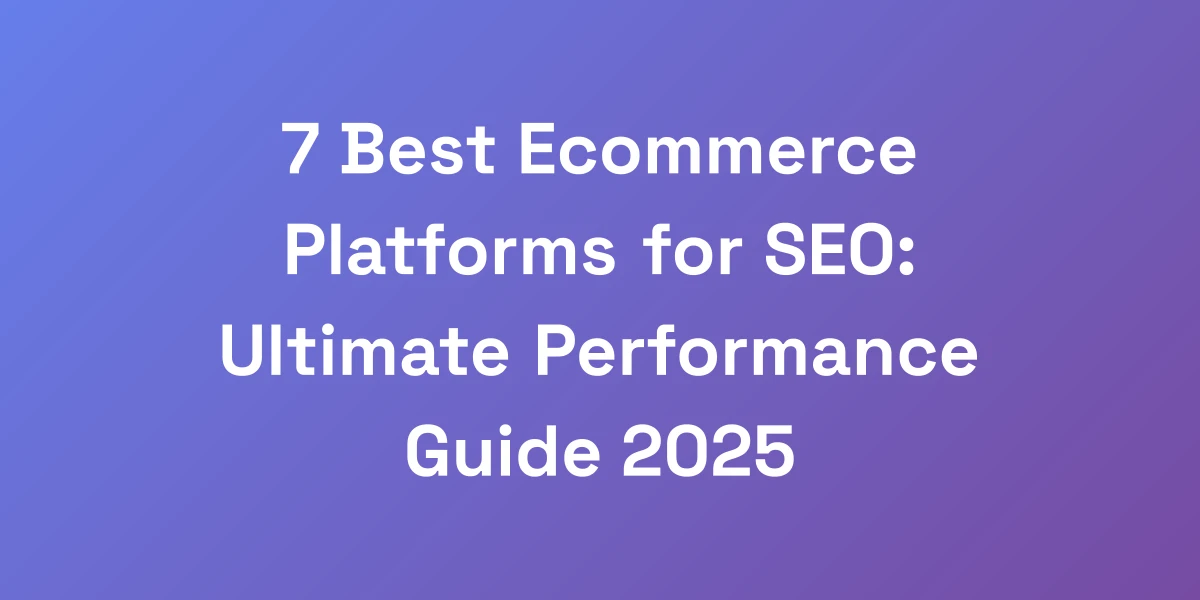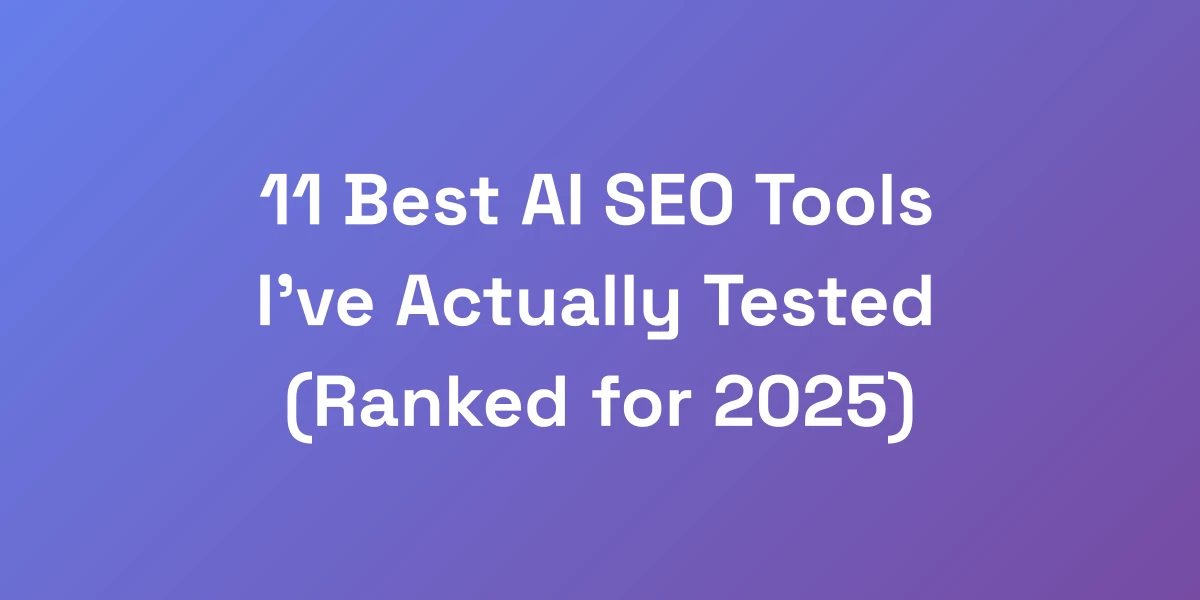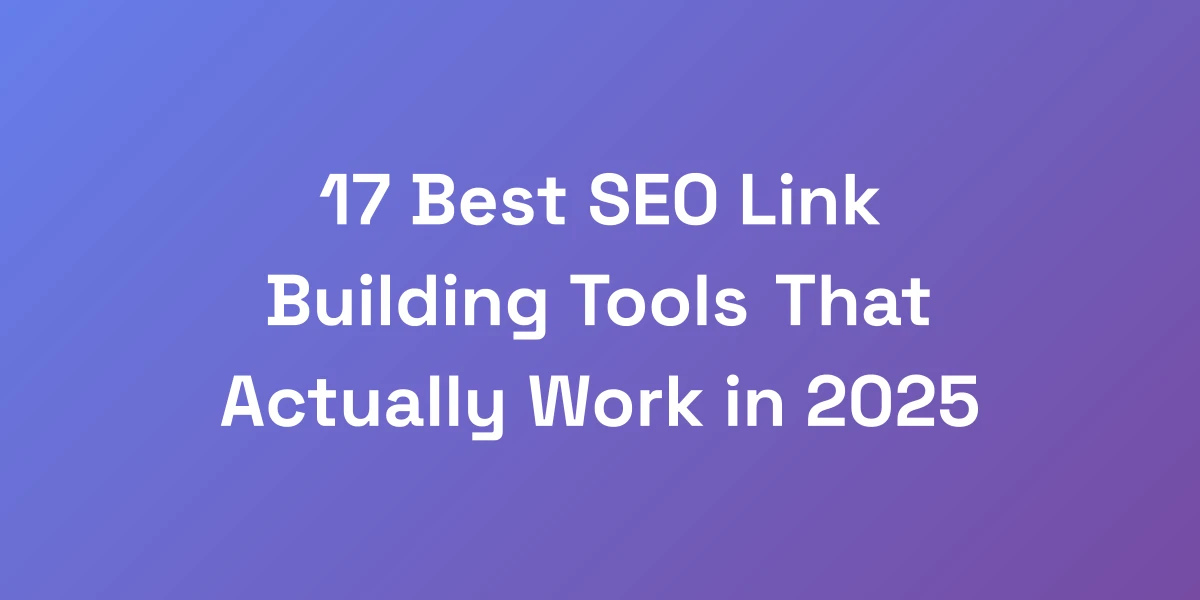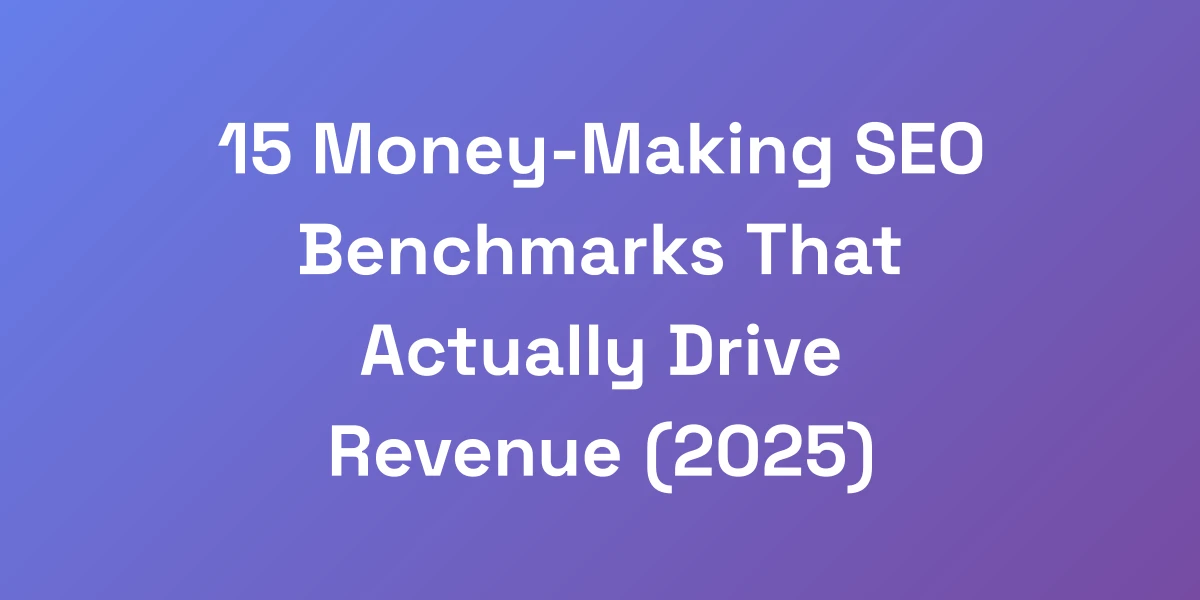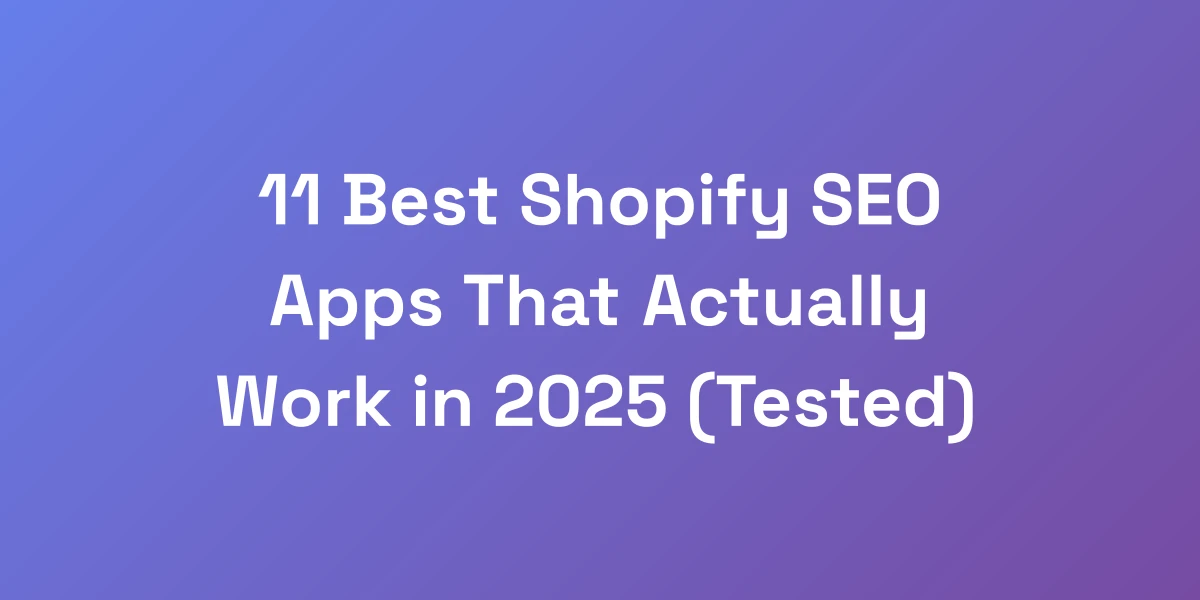
Best CMS for SEO in 2025: 7 Platforms That Actually Drive Traffic
Mar 12, 2025 | By [email protected]
Why 90% of Websites Fail at SEO (And How the Right CMS Changes Everything)
Let me hit you with some truth: Most websites are dead on arrival because they picked the wrong foundation.
We’ve seen it time and again—businesses invest time, money, and resources into their online presence, only to watch their efforts crumble. Why? Because they didn’t recognize the pivotal role their CMS choice plays in their SEO success.
I’ve spent millions testing different CMS platforms, and here’s what nobody tells you—your CMS choice can make or break your SEO game before you even start.
The difference between ranking #1 and being buried on page 7 often comes down to your initial CMS decision. It’s not just about aesthetics or ease of use; it’s about building a structure that supports robust SEO strategies.
In this guide, we’ll dive deep into the world of CMS platforms in 2025, uncovering the key reasons why most websites fail at SEO and how selecting the right CMS can transform your online visibility. Ready to take your SEO game to the next level? Let’s get into it.
The Hidden Cost of Choosing the Wrong CMS
Choosing the wrong CMS is like laying a shaky foundation for a skyscraper. The immediate costs might seem negligible, but over time, the consequences stack up.
Imagine investing heavily in content creation, only to find your site struggles with load times, poor mobile responsiveness, and limited customization options. These issues can severely hinder your SEO performance, leading to higher bounce rates and lower search rankings.
Moreover, switching CMS platforms mid-way can be a costly and time-consuming endeavor. You’re not just migrating content; you’re also re-establishing your SEO credentials, which can result in temporary rankings drops and lost traffic.
To avoid these hidden costs, it’s crucial to thoroughly evaluate a CMS’s SEO capabilities before committing. Look beyond surface-level features and delve into how each platform handles technical SEO aspects like URL structures, meta tags, and schema markup.
Taking the time upfront to choose the right CMS can save you from future headaches and set the stage for sustained SEO success.
Core Technical SEO Requirements for Modern Websites
In the ever-evolving landscape of SEO, technical excellence is non-negotiable. Your CMS must support the fundamental SEO requirements that modern websites demand.
First and foremost, page speed is a critical factor. Slow-loading pages not only frustrate users but also negatively impact your search rankings. Your CMS should offer robust caching mechanisms, optimize image loading, and minimize unnecessary scripts to keep your site running smoothly.
Next, consider mobile responsiveness. With Google’s mobile-first indexing, a responsive design is essential. Ensure your CMS provides flexible, mobile-friendly templates and seamless adaptability across various devices.
URL structure is another key element. Clean, readable URLs are favored by search engines and users alike. Your CMS should allow for customizable URL structures without relying on complex configurations or plugins.
Additionally, effective meta tag management is crucial. From title tags to meta descriptions, your CMS should enable easy editing and optimization of these elements to enhance your content’s visibility and click-through rates.
Lastly, integration with SEO tools and plugins can significantly boost your optimization efforts. A CMS with a rich ecosystem of SEO-friendly plugins can provide the additional functionalities you need to stay ahead in the competitive SEO game. For a deeper dive into how automation can enhance your SEO strategies, check out our guide on SEO Automation in 2025: A Complete Guide to AI-Powered Success.
Why Traditional CMS Rankings Are Misleading
Traditional CMS rankings often emphasize market share or feature lists without considering the specific SEO needs of your website. This approach can be misleading because what works for one site might not work for another.
For instance, WordPress dominates the market with over 43% of all websites, but a highly customized static site might fare better in terms of speed and security. Similarly, a niche-specific CMS could outperform a general-purpose platform in specific SEO metrics.
Moreover, rankings typically don’t account for the flexibility and scalability required to adapt to ongoing SEO changes. Search engines are constantly updating their algorithms, and your CMS needs to be agile enough to implement necessary adjustments swiftly.
Therefore, it’s essential to look beyond generic rankings and assess how each CMS aligns with your unique SEO goals and technical requirements. Focus on platforms that offer comprehensive SEO support, robust technical features, and the flexibility to evolve alongside your business.
The Real Metrics That Matter for SEO Success
When evaluating CMS platforms for SEO, it’s easy to get bogged down by superficial metrics. Instead, focus on the real indicators that drive SEO success.
Firstly, Core Web Vitals are a set of metrics that measure user experience and page performance. These include loading speed, interactivity, and visual stability. A CMS that can consistently achieve high Core Web Vitals scores will likely perform better in search rankings.
Secondly, technical SEO capabilities such as schema markup, XML sitemap generation, and robots.txt management are vital. These features help search engines understand and index your content more effectively.
Thirdly, content management flexibility is crucial. Your CMS should support the creation and optimization of high-quality, engaging content without cumbersome restrictions. This includes easy media uploads, rich text editing, and robust content structuring options.
Lastly, integration with analytics and SEO tools cannot be overlooked. The ability to seamlessly connect with tools like Google Analytics, Search Console, and various SEO plugins can provide invaluable insights and streamline your optimization efforts.
By prioritizing these metrics over generic feature lists, you can select a CMS that truly supports your SEO ambitions and drives sustained growth.
WordPress: Still the Undisputed SEO Champion (With a Catch)
Here’s the deal—WordPress powers over 43% of all websites for a reason. But it’s not because it’s the “best” out of the box.
It’s because it gives you unlimited SEO scaling potential if you know how to unlock it. We’ve built multiple 8-figure businesses on WordPress, and I’ll tell you exactly why it crushes every other CMS for SEO—but also where it falls short and how to patch those weaknesses.
The key is in the configuration, not just the installation.
Essential WordPress SEO Plugins That Actually Move the Needle
WordPress’s vast ecosystem of over 58,000 plugins includes some of the most powerful SEO tools available. These plugins are not just add-ons; they are essential for optimizing your site’s SEO performance.
Yoast SEO is a staple, offering comprehensive on-page optimization features. From keyword optimization to readability analysis, Yoast helps ensure your content meets SEO best practices.
SEO Ultimate is another top contender, providing advanced features like breadcrumb generation, title and meta tag templating, and more intricate SEO controls that give your site a competitive edge.
Don’t overlook Rank Math, a newer plugin that’s rapidly gaining popularity for its user-friendly interface and extensive feature set, including built-in schema markup and seamless integration with Google Search Console.
All in All, leveraging these plugins can transform WordPress into a formidable SEO powerhouse, but it requires a strategic approach to plugin selection and configuration.
Speed Optimization Secrets for WordPress
Speed is a critical factor for both user experience and SEO. Luckily, WordPress offers several ways to optimize your site’s performance.
First, implement a reliable caching plugin like WP Rocket. Caching reduces server load and decreases page load times by storing static versions of your pages.
Next, optimize your images with plugins like Smush or ShortPixel. These tools compress images without sacrificing quality, ensuring faster load times.
Consider using a Content Delivery Network (CDN) such as Cloudflare to distribute your content globally, reducing latency and improving load speeds for international visitors.
Additionally, minimize the use of heavy themes and unnecessary plugins. A streamlined, lightweight setup can significantly boost your site’s speed.
Lastly, ensure your hosting provider offers robust performance features. Managed WordPress hosts like Kinsta or WP Engine are optimized for speed and reliability, providing a solid foundation for your SEO efforts.
Custom Schema Implementation Strategies
Schema markup is essential for enhancing your site’s visibility in search results by providing additional context to search engines.
With WordPress, implementing schema is straightforward thanks to plugins like Schema Pro and Yoast SEO. These tools allow you to add structured data to your pages effortlessly.
For advanced users, manually adding schema via JSON-LD scripts can offer greater control and customization. This approach is beneficial for businesses with specific structured data needs that go beyond what plugins can offer.
Actionable Tip: Start with basic schema types like articles, products, and FAQs, then gradually implement more complex schemas such as event, recipe, or review schema as your site grows.
Content Architecture Best Practices
A well-structured content architecture is the backbone of effective SEO. WordPress provides the flexibility to create a logical hierarchy that search engines love.
Organize your content using categories and tags to create a clear navigational structure. This not only helps users find their way around your site but also assists search engines in understanding the relationship between different pieces of content.
Utilize custom post types and custom fields to manage specific types of content more efficiently. This can improve site organization and make it easier to optimize for relevant keywords.
Implementing a silo structure can further enhance your content architecture. By grouping related content together, you reinforce topical relevance and improve your site’s authority on specific subjects.
Don’t forget to optimize your internal linking strategy. Thoughtfully linking related articles and pages helps distribute link equity throughout your site, boosting overall SEO performance.
Actionable Tip: Use breadcrumb navigation to enhance user experience and improve SEO by creating a clear path from your homepage to deeper content.
Advanced WordPress SEO Automation
Automation can take your WordPress SEO efforts to the next level, saving time and ensuring consistency across your site.
Tools like WP All Import combined with SEO plugins can automate the process of adding meta tags and other SEO elements to bulk content. This is especially useful for large sites with extensive content libraries.
Automate your image optimization by integrating image compression plugins that automatically optimize images upon upload. This ensures that your site remains fast without manual intervention.
Set up automated backups and security scans to protect your site from vulnerabilities that could negatively impact your SEO performance. Plugins like UpdraftPlus and Wordfence can handle these tasks efficiently.
Implement automated reporting using tools like Google Analytics and SEMrush integrations to keep track of your SEO performance. This allows you to make data-driven decisions without constantly monitoring analytics manually.
Actionable Tip: Schedule regular SEO audits using plugins or external tools to identify and rectify issues proactively, keeping your site optimized and competitive.
Headless CMS: The Future of SEO Performance
Listen carefully: The future of SEO isn’t about choosing between traditional CMS platforms—it’s about building a custom stack that gives you complete control.
Headless CMS solutions are changing the game for serious businesses. We’re talking sub-second load times, perfect Core Web Vital scores, and unlimited scaling potential. But here’s the catch—you need to know exactly how to set them up, or you’ll waste months of development time.
Understanding the Headless CMS Advantage
A headless CMS separates the backend from the frontend, allowing you to manage content independently of how it’s presented to users. This architecture offers unparalleled flexibility and performance benefits that traditional CMS platforms can’t match.
Key Advantages Include:
- Faster Load Times: By decoupling the frontend, headless CMSs can deliver content more efficiently, improving page speed and overall user experience.
- Scalability: Easily scale your content delivery across multiple platforms and devices without being constrained by the frontend framework.
- Flexibility: Use any frontend technology or framework, giving you complete control over the design and functionality of your site.
- Enhanced Security: With no direct connection between the frontend and backend, headless CMSs reduce the risk of security vulnerabilities.
Actionable Tip: Consider a headless CMS if you need to deliver content across multiple channels and prioritize performance and scalability. However, be prepared for a more complex setup process.
Top Headless CMS Platforms for SEO
Not all headless CMS platforms are created equal. Here are some of the top contenders that excel in SEO performance:
- Contentful: Known for its robust API capabilities, Contentful allows seamless integration with various frontend frameworks, ensuring optimal performance and flexibility.
- Strapi: An open-source headless CMS that offers extensive customization options and ease of use, making it a favorite among developers.
- Sanity: Offers real-time collaboration and a flexible content model, perfect for dynamic content needs and smooth SEO optimization.
- Prismic: Features a user-friendly interface and powerful integration options, enabling efficient content management and SEO performance.
- Ghost: Primarily focused on publishing, Ghost provides excellent out-of-the-box SEO features, making it ideal for content-heavy sites.
Actionable Tip: Evaluate each platform based on your specific SEO needs, such as API capabilities, ease of integration, and customization options. Choose one that aligns with your technical expertise and long-term goals.
Implementation Strategies and Pitfalls
Implementing a headless CMS requires careful planning and execution to avoid common pitfalls.
Strategies for Successful Implementation:
- Define Clear Goals: Understand what you aim to achieve with a headless CMS, whether it’s improved performance, better scalability, or enhanced content delivery across multiple channels.
- Choose the Right Frontend: Select a frontend framework that complements your CMS and supports the performance and SEO features you need.
- Plan Your Content Architecture: Design a content model that is flexible and scalable, allowing for easy updates and optimizations as your site grows.
- Leverage APIs: Make full use of the CMS’s API capabilities to integrate with other tools and services, enhancing your SEO strategy.
Common Pitfalls to Avoid:
- Lack of Technical Expertise: Headless CMSs require more technical knowledge to implement and manage. Ensure you have the necessary skills or a reliable team in place.
- Ignoring SEO Best Practices: Don’t overlook fundamental SEO principles. Even with a headless CMS, you need to optimize content and structure effectively.
- Poor Integration: Ensure seamless integration between your CMS and other tools like analytics, SEO plugins, and marketing platforms.
- Overcomplicating the Setup: While flexibility is a benefit, overcomplicating your setup can lead to inefficiencies and maintenance challenges.
Actionable Tip: Start with a pilot project to test your headless CMS setup before fully committing. This allows you to identify and address any issues early on.
Performance Metrics and Case Studies
Measuring performance is crucial to understanding the impact of your headless CMS on SEO. Focus on key metrics such as Core Web Vitals, page load times, and mobile performance.
Case Study: Contentstack Implementation
Contentstack helped a major e-commerce site achieve a 30% increase in page speed, leading to a 15% boost in organic traffic. By leveraging Contentstack’s flexible API and robust content delivery network, the site was able to provide a seamless user experience across all devices.
Case Study: Sanity for a Media Company
A leading media company implemented Sanity as their headless CMS, resulting in a 25% improvement in content delivery speed and a significant reduction in bounce rates. The real-time collaboration features also enhanced their content management process, contributing to higher quality and more engaging content.
Actionable Tip: Regularly monitor your performance metrics using tools like Google Analytics and Search Console. Use these insights to continuously refine and optimize your CMS setup for better SEO results.
Cost-Benefit Analysis for Different Business Sizes
Headless CMS platforms can vary significantly in cost, depending on the size and needs of your business.
For Small Businesses:
- Contentful offers a free tier with basic features, making it accessible for startups and small businesses looking to scale.
- Ghost provides affordable plans with excellent SEO features, ideal for bloggers and small content sites.
For Medium-Sized Businesses:
- Strapi offers scalable pricing and extensive customization options, suitable for growing businesses with more complex content needs.
- Sanity provides flexible pricing based on usage, allowing medium-sized businesses to pay for what they need without overcommitting.
For Large Enterprises:
- Contentful and Prismic offer enterprise-level plans with advanced features and dedicated support, perfect for large organizations with extensive content management requirements.
- Headless WordPress setups can be highly customized to meet the demands of large enterprises, providing both scalability and robust SEO capabilities.
Actionable Tip: Conduct a thorough cost-benefit analysis considering your current needs and future growth. Factor in not just the upfront costs but also ongoing maintenance and potential scalability to ensure long-term value.
Shopify vs. WooCommerce: The E-commerce SEO Battle
If you’re selling products online, this section could save you hundreds of thousands in lost revenue. We’ve tested both platforms extensively, and the results might surprise you.
While Shopify offers incredible out-of-the-box SEO features, WooCommerce can actually outperform it with the right setup. The key is understanding which platform aligns with your specific business model and growth trajectory.
Let us break down the exact scenarios where each platform wins.
SEO Feature Comparison
Both Shopify and WooCommerce offer robust SEO features, but they approach them differently.
Shopify comes with built-in SEO features such as automated sitemaps, SSL certificates, and customizable title tags and meta descriptions. It also optimizes load times out of the box, which is a significant advantage for SEO.
WooCommerce, as a WordPress plugin, inherits all of WordPress’s SEO capabilities. With plugins like Yoast SEO or Rank Math, WooCommerce offers more granular control over on-page SEO elements, allowing for more sophisticated optimization strategies.
Actionable Tip: If you need a straightforward, hassle-free setup with essential SEO features readily available, Shopify is a strong contender. However, if you require advanced SEO customization and are comfortable managing plugins, WooCommerce offers greater flexibility.
Performance Benchmarks
Performance is a critical SEO factor, and both platforms perform well, but with different strengths.
Shopify is known for its optimized infrastructure, ensuring fast load times and high uptime rates. Its CDN integration and efficient hosting environment help maintain excellent Core Web Vitals scores.
WooCommerce, on the other hand, relies heavily on the quality of your hosting provider and the optimization of your WordPress setup. With proper configuration and performance optimization plugins, WooCommerce can achieve comparable load times and performance metrics to Shopify.
Actionable Tip: Invest in high-quality hosting for WooCommerce to match Shopify’s performance standards. Utilize performance optimization plugins and regularly monitor your site’s speed to ensure it stays competitive.
Custom Development Requirements
Shopify is a hosted solution that limits backend access, which can be a drawback if you need extensive customization. However, its templating language, Liquid, allows for significant frontend customization.
WooCommerce offers full control over your site’s codebase, enabling deep customization and integration with other systems. This flexibility is ideal for businesses with specific requirements that go beyond what Shopify’s ecosystem can accommodate.
Actionable Tip: Choose Shopify if you prefer a managed platform with less technical overhead. Opt for WooCommerce if you need extensive customization and have the technical expertise or resources to manage it.
Scaling Considerations
As your business grows, so do your website’s demands. Shopify scales effortlessly with its managed hosting and built-in features that handle high traffic without requiring additional configuration.
WooCommerce can scale too, but it demands more effort in terms of optimizing your hosting environment, managing plugins, and ensuring your site can handle increased traffic loads. Proper planning and investment in infrastructure are essential for scaling WooCommerce effectively.
Actionable Tip: If you anticipate rapid growth and prefer a solution that scales seamlessly without much intervention, Shopify is the better choice. For businesses that require a highly customizable and scalable solution with the right technical support, WooCommerce remains a strong option.
Cost Analysis Over Time
Cost is a significant factor when choosing between Shopify and WooCommerce, especially as your business grows.
Shopify operates on a subscription-based model, with plans starting at around $29 per month. While it includes hosting, security, and basic SEO features, additional costs can accumulate with the use of premium apps and transaction fees if you don’t use Shopify Payments.
WooCommerce is free as a plugin, but you need to account for hosting fees, premium themes, and paid plugins for advanced functionality. While the initial costs can be lower, ongoing expenses for hosting and extensions can add up, especially as your site scales.
Actionable Tip: Calculate the total cost of ownership for both platforms based on your business size and growth projections. Shopify offers predictable monthly costs, whereas WooCommerce’s expenses can vary, making it essential to budget accordingly.
The Dark Horse CMS Platforms That Are Crushing It
While everyone’s fighting over WordPress and Shopify, some lesser-known CMS platforms are quietly dominating specific niches. We’re talking about platforms like Webflow, Storyblok, and Prismic that are outperforming traditional CMS in certain scenarios.
These platforms aren’t for everyone, but in the right hands, they’re SEO powerhouses. Here’s where they excel and where they fall short.
Rising Star CMS Platforms
Webflow stands out with its design-centric approach, allowing developers and designers to create highly customized, responsive sites without sacrificing SEO. Its built-in SEO tools and fast load times make it a strong contender for businesses prioritizing both aesthetics and performance.
Storyblok offers a robust headless CMS solution that provides exceptional flexibility for developers. Its visual editor and component-based architecture make managing content intuitive while ensuring optimal SEO performance through customizable content delivery.
Prismic is another rising star, known for its ease of use and powerful content management capabilities. It integrates seamlessly with modern frontend frameworks, ensuring fast load times and excellent SEO metrics.
Actionable Tip: Explore these platforms if you require a high degree of customization and are comfortable with a slightly steeper learning curve. They can offer significant SEO benefits when leveraged correctly.
Niche-Specific Success Stories
Different businesses have unique needs, and certain CMS platforms cater to specific niches more effectively.
Webflow is ideal for agencies and freelance designers who need to deliver unique, visually stunning sites quickly. Its user-friendly interface and powerful design tools make it a favorite for creative professionals.
Storyblok excels for e-commerce and content-heavy sites that require a flexible, headless approach. Brands looking to deliver content across multiple channels appreciate its robust API and seamless integrations.
Prismic is perfect for SaaS companies and large enterprises that need a scalable, headless solution to manage complex content structures and deliver personalized experiences.
Actionable Tip: Identify your industry’s specific needs and explore how these niche CMS platforms can address them more effectively than traditional options.
Technical SEO Capabilities
When it comes to technical SEO, these dark horse CMS platforms offer advanced features that can boost your site’s performance.
Webflow provides advanced SEO configurations, including customizable meta tags, automatic sitemap generation, and built-in 301 redirects. Its server-side rendering ensures fast load times, directly impacting SEO positively.
Storyblok supports comprehensive SEO strategies with features like customizable URL structures, dynamic content delivery, and easy integration with SEO tools. Its headless architecture allows for precise control over how content is served and indexed by search engines.
Prismic offers excellent SEO support through customizable content models, flexible URL management, and API-driven content delivery. Its integration capabilities ensure that you can implement advanced SEO practices seamlessly.
Actionable Tip: Leverage the advanced SEO features of these platforms to fine-tune your site’s technical SEO elements, ensuring they align with the latest search engine guidelines.
Integration Ecosystems
A robust integration ecosystem is essential for optimizing your CMS’s SEO capabilities. These platforms excel in this area, providing seamless connections with various tools and services.
Webflow integrates easily with Google Analytics, Search Console, and numerous third-party marketing tools, allowing you to track and optimize your SEO performance effectively.
Storyblok offers extensive API integrations, enabling you to connect with popular SEO tools, analytics platforms, and other marketing services. This flexibility enhances your ability to implement comprehensive SEO strategies.
Prismic integrates well with modern frontend frameworks and marketing tools, ensuring your SEO efforts are supported by a powerful, interconnected ecosystem.
Actionable Tip: Ensure that your chosen CMS can integrate smoothly with your preferred SEO tools and analytics platforms to streamline your optimization efforts and gain deeper insights into your performance.
Future Growth Potential
Choosing a CMS with strong future growth potential is crucial for long-term SEO success.
Webflow continues to evolve with new features focused on enhancing design and performance, ensuring it remains a top choice for businesses prioritizing both aesthetics and SEO.
Storyblok is expanding its headless CMS capabilities, driven by the growing demand for flexible content management solutions, making it a solid choice for forward-thinking businesses.
Prismic is continuously improving its integration capabilities and content delivery options, positioning itself as a future-proof solution for businesses aiming to scale and innovate.
Actionable Tip: Select a CMS that not only meets your current SEO needs but also adapts to future trends and technologies, ensuring sustained performance and growth.
Making Your Final CMS Decision (A Framework That Works)
Stop overthinking your CMS choice. We’re going to give you a simple but powerful framework that will help you make the right decision in under 30 minutes.
We’ll focus on the three critical factors that actually matter for SEO success, and I’ll show you exactly how to weigh them based on your specific situation. This is the same framework we use for our own ventures and consulting clients.
The 3-Factor Decision Matrix
When choosing a CMS, consider the following three critical factors:
- SEO Capabilities: Does the CMS support advanced SEO features such as customizable meta tags, schema markup, and fast load times?
- Flexibility and Scalability: Can the CMS grow with your business, accommodating increased traffic, more content, and evolving SEO strategies?
- Ease of Use and Support: Is the CMS user-friendly, and does it offer reliable support and a strong community for troubleshooting and guidance?
Actionable Tip: Create a scorecard based on these factors and evaluate each CMS platform accordingly. Assign weights to each factor based on your priorities to determine the best fit.
Resource Requirement Analysis
Assess the resources you have available and what you’ll need to manage your CMS effectively.
- Technical Expertise: Do you have the in-house skills to manage a complex CMS, or will you need to hire or outsource?
- Budget: What is your budget for initial setup, ongoing maintenance, and potential scaling in the future?
- Time: How much time can you dedicate to setting up and optimizing your CMS?
Actionable Tip: Match your CMS choice with your available resources. If you lack technical expertise, a managed solution like Shopify or WordPress with robust plugin support might be more suitable.
Growth Trajectory Mapping
Consider where your business is headed and how your CMS will support that growth.
- Expansion Plans: Are you planning to expand your product lines, enter new markets, or scale your content strategy?
- SEO Goals: What are your long-term SEO objectives, and can your CMS support the strategies needed to achieve them?
- Technological Advancements: Will your CMS be able to integrate with emerging technologies like AI-driven content optimization or new marketing tools?
Actionable Tip: Choose a CMS that not only meets your current needs but also aligns with your future goals. This ensures that as your business evolves, your CMS remains a valuable asset rather than a limiting factor.
Risk Assessment Strategy
Identify potential risks associated with each CMS option to make an informed decision.
- Security Vulnerabilities: How secure is the CMS, and how frequently are updates and patches released?
- Vendor Lock-In: Are you tied to a specific vendor, or can you easily migrate to another platform if needed?
- Downtime and Reliability: What is the CMS’s track record for uptime and reliability?
Actionable Tip: Conduct a risk analysis for each CMS option, considering factors like security, flexibility, and reliability. Choose a platform that minimizes potential risks and offers strong support and community backing.
Implementation Timeline Planning
Plan out the timeline for implementing your chosen CMS to ensure a smooth transition and minimize disruptions.
- Migration Strategy: How will you migrate existing content and data to the new CMS without losing SEO value?
- Training and Onboarding: What training will your team need to effectively use the new CMS?
- Testing and Optimization: How will you test the new setup to ensure it meets your SEO and performance goals?
Actionable Tip: Develop a detailed implementation plan with clear milestones and responsibilities. Allocate sufficient time for testing and optimization to ensure your new CMS setup is fully optimized for SEO success before going live.
Conclusion
Choosing the right CMS is a foundational step in building a successful SEO strategy. From the tried-and-true WordPress to the innovative headless CMS options, each platform offers unique strengths that can significantly impact your website’s performance and search rankings.
By understanding the hidden costs of the wrong CMS, mastering the core technical SEO requirements, and leveraging advanced SEO tools and strategies, you can ensure your site not only survives but thrives in the competitive online landscape.
Additionally, incorporating effective business blogging strategies can further amplify your SEO efforts by attracting and engaging your target audience consistently.
Remember, it’s not just about the features on paper—it’s about how those features align with your specific business needs and growth trajectory. Whether you’re leaning towards the flexibility of a headless CMS or the comprehensive features of Shopify and WooCommerce, the right choice can propel your SEO efforts to new heights.
Ready to elevate your website’s SEO? Take the time to evaluate your options using the framework we’ve outlined, and choose a CMS that supports your vision and goals.
Have questions or need personalized advice on selecting the best CMS for your SEO strategy? Reach out to us and let’s build a roadmap to your online success together.
What’s your experience with different CMS platforms? Share your stories and insights in the comments below—we’d love to hear from you!
For startups looking to scale their SEO efficiently, explore our SEO for Startups: The $0 to $1M Growth Playbook (2025) to discover strategies that can set your business apart without breaking the bank.
Freelancers aiming to master SEO can benefit greatly from our Ultimate SEO Freelancer’s Blueprint: From Beginner to Pro in 2024, which provides a comprehensive guide to building and scaling a successful SEO freelance business.
